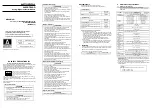4
mio4 Hardware Layout
1.
Power button
- Sleep Mode: Hold for 2 seconds
until the green LED goes out, then
release.
- Wake: Touch button briefly.
- Hard-reset: Hold button for 7
seconds; all LEDs light up; release
button.
- Bootloader mode to receive
firmware updates: Hold button 4
seconds until power LED turns red;
release button. MIDI 1 and MIDI2
lights alternate on and off. Press
and hold to abort bootloader
mode.
2. Power LED
Green indicates mio is powered up
normally.
3. MIDI DIN 1 - 4 LED
s
Indicate that MIDI data is being
sent/received at corresponding
MIDI DIN jacks.
4. USB Host jack LED
Indicates that MIDI data is being
sent/received over the USB MIDI
hosting jack.
5. USB Device Jacks LED
Indicates MIDI is being sent to/from
a computer in one of the two USB-B
computer device jacks.
6. Network jack LED
Indicates that MIDI is being
sent/received over the network.
7. MIDI DIN 1 in/out jack
pair (front
panel)
8. MIDI DIN 2- 4 in/out jack pair
s
(rear panel)
Connect standard 5-pin MIDI DIN
equipment.
9. USB Device jack 1
USB computer device jack for a Mac
or PC, using a standard USB-B cable.
Does not power the device or
support firmware loading.
10. USB Device jack 2 (power)
USB computer device jack for a Mac
or PC. Powers the device over the
USB bus. Supports firmware
loading. Accepts a USB-B cable.
Note: mio4 may also be powered
by the optional iConnectivity power
adapter.
11. USB Host jack
USB MIDI hosting jack accepts
Class-Compliant USB MIDI devices
only. In general, USB MIDI devices
that require a software driver to
operate are
not
Class-Compliant.
(Optional) Accepts a powered USB
2.0 or 3.0 hub to access up to eight
Class-Compliant MIDI devices.
Note: We recommend looking for
the "USB Certified" sticker to
ensure your hub meets power
requirements.
12. Network jack
Ethernet jack for Network MIDI.
Supports up to four Network MIDI
sessions, each with a single bank of
16 MIDI channels.
- May be connected to a Wi-Fi
router for wireless MIDI.
- Please see the
section for set up instructions.
13.
Power supply jack
mio4 may also be powered by the
optional iConnectivity power
adapter (9V @2A 18W, 2mm). This
allows operation without a
computer, and also powers a USB
device in the USB Host jack.
14. Security lock port
(right side)
Summary of Contents for mio4
Page 1: ...Version 1 0 OWNER S MANUAL ...
Page 2: ...Version 1 0 ...


















